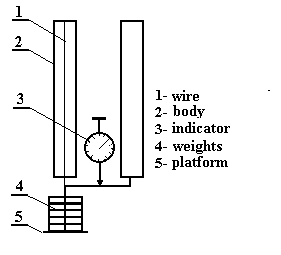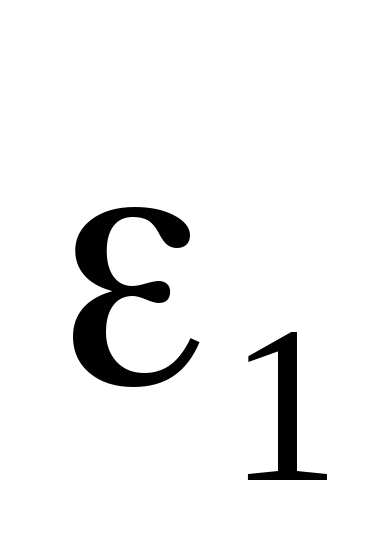
- •1 Елементи теорії похибок
- •1.1 Основні поняття теорії похибок
- •Як правило, визначається у відсотках
- •1.2 Похибки засобів вимірювання
- •1.3 Похибки табличних величин
- •1.4 Правила округлення і виконання наближених обчислень
- •1.5 Похибки прямих вимірювань Похибки прямих вимірювань визначаються за формулою
- •1.6 Похибки непрямих вимірювань
- •1.7 Графічне відображення експериментальних результатів
- •Контрольні запитання
- •2 Elements of the theory of errors
- •2.1 Principal concepts of the theory of errors
- •2.2 Errors of instruments
- •2.3 Error of table quantities, count and rules of approximations
- •2.4 Errors of direct measurement
- •2.5 Errors of indirect measurements
- •2.6 Graph presentation of the experimental results
- •Control questions
- •3. Лабораторна робота № 1. Визначення густини тіл
- •3.1 Вступ
- •3.2 Вимірювання і визначення похибок
- •Контрольні запитання
- •4 Laboratory work № 1. Definition of a body density
- •4.1 System International units
- •4.2 Volume
- •4.3 Vernier scale
- •4.4 Micrometer screw gauge
- •4.5 Measurement of mass
- •4.6 Measurement of weight
- •4.7 Experimental Part
- •5 Лабораторна робота № 2. Визначення модуля юнга металів
- •5.1 Вступ
- •5.2 Опис установки
- •5.3 Порядок виконання роботи
- •Контрольні запитання
- •6 Laboratory work № 2. Measuring of Yung modulus of metals
- •6.1 Introduction
- •6.3 Experimental device
- •6.3 Experimental part
- •Control questions
- •Literature
- •7 Лабораторна робота № 3. Визначення коефіцієнта внутрішнього тертя методом стокса
- •7.1 Опис установки
- •7.2 Теорія методу Стокса
- •7.3 Порядок виконання роботи (завдання 1)
- •7.4 Порядок виконання роботи (завдання 2)
- •Контрольні запитання
- •8 Laboratory work № 3. Measuring the coefficient of internal friction by stocks’ method
- •8.1 Theory
- •8.2 Experimental part
- •Control questions
- •9 Лабораторна робота № 4.1. Пружний удар куль
- •9.1 Коротка теорія пружного удару
- •9.2 Порядок виконання роботи
- •Контрольні запитання
- •10 Лабораторна робота № 4.2. Пружний і непружний удаРи куль
- •10.1 Основні положення
- •10.2 Порядок виконання роботи
- •Контрольні запитання
- •Список літератури
- •11 Laboratory work № 4. Elastic impact of bodies
- •11.1 Task
- •11.2 Short theory
- •11.3 Elastic impact
- •11.4 Experimental part
- •Control questions
- •12 Лабораторна робота № 4.3. Непружний удар тіл
- •12.1 Коротка теорія непружного удару
- •12.2 Порядок виконання роботи
- •Контрольні запитання
- •Інструкцію склав доцент кафедри фiзики Манько в.К.
- •13 Laboratory work № 4.3. Inelastic impact of bodies
- •13.1 Short theory of inelastic impact
- •13.2 The sequence of performing the work
- •Control questions
- •Literature
- •2 Вимоги безпеки перед початком роботи
- •3 Вимоги безпеки під час виконання робіт
- •4 Вимоги безпеки після закінчення роботи
- •5 Вимоги безпеки в аварійних ситуаціях
6.3 Experimental device
The experimental device is shown in fig.6.3.

Figure 6.3
Wire 1 is fixed on body 2. Platform 5 is fixed to the end of the wire. Weights 4 are placed on the platform. Lengthening of the wire is measured with the indicator of lengthening 3.
6.3 Experimental part
-
Measure the diameter of the wire with the slide gauge and the length of the wire with a ruler.
-
Load the wire with 2÷3 weights to make it straight.
-
Fix the zero rotating the indicator scale.
-
Measure the lengthening of the wire Δl gradually loading it with the weights. Force F applied to the wire equals the sum of weights being loaded to the wire. Put down the results of the measurements m, F, Δl in a table 6.2. The length of the wire and its diameter are l = 1100 mm, d = 0,6 mm. Calculate mechanical stress and relative deformation according to formula 6.3 and 6.4. Put down the results in table 6.2.
Table 6.2
|
№ |
m, кg |
F, H |
Δl,10-2, mm |
, МPа |
ε |
l , mm |
d , mm |
|
1 |
|
|
|
|
|
1100 |
0.6 |
|
2 |
|
|
|
|
|
||
|
3 |
|
|
|
|
|
||
|
4 |
|
|
|
|
|
||
|
5 |
|
|
|
|
|
||
|
6 |
|
|
|
|
|
||
|
7 |
|
|
|
|
|
||
|
8 |
|
|
|
|
|
||
|
9 |
|
|
|
|
|
||
|
10 |
|
|
|
|
|
-
Plot the dependency of σ = f(ε) accordingly to fig. 6.4, i.e. draw the best straight line lying in the maximum density of experimental points. Choose any of two points 1 and 2 (but not from the table) to which values of
 ,
,
 and
and
 ,
,
 accordingly.
accordingly.

Figure 6.4
-
Calculate modulus of Yung by the formula:
![]() (6.6)
(6.6)
Having such a method of determining the coefficient of proportionality (fig.6.4) between any values that laniary are related one to another, the all the totality of experimental data but not accidental value of any measurement is used. Using the data from table 6.1 determine the material of the wire.
-
Using the theory of errors estimate relative error of measurement Modulus of Yung by the formula:
 ,
(6.7)
,
(6.7)
where the value δl calculate according to the formula:
![]() ,
(6.8)
,
(6.8)
where
δ = 0.01 mm;
![]() .
According
to
the
formula:
.
According
to
the
formula:
![]() (6.9)
calculate the values:
l
(
(6.9)
calculate the values:
l
(![]() ),
m
(
),
m
(![]() ),
g
(
),
g
(![]() ),
(
),
(![]() ),
d
(
),
d
(![]() ).
).
6. On the base of relation σ = f(ε) make the conclusion if the Hook Law is true.
